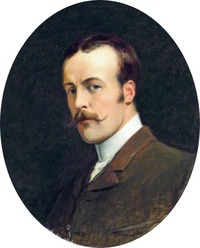Andrew Carrick Gow
56°00′00″N 2°30′50″W / 56.000°N 2.514°W
Andrew Carrick Gow | |
|---|---|
 Self-portrait at the age of 35, 1883 | |
| Born | 8 June 1848 London, the United Kingdom |
| Died | 1 February 1920 (aged 71) London, the United Kingdom |
| Nationality | British |
| Elected | Member of the Royal Academy, 1890 |
Andrew Carrick Gow RA (London 15 June 1848 – 1 February 1920 London) was a British painter who painted scenes from British and European history as well as portraits and genre.
He studied at Heatherley's School of Art. He was a regular exhibitor at the Royal Academy, and elsewhere from 1867 onwards, and in 1880, he was elected an Associate of the Royal Academy, become a full Royal Academician in 1890. In 1900, he visited Egypt and he used his sketches to compose a scene representing the death of the Mahdi soon after the defeat of his troops by Colonel Wingate in 1898. The artist Lawrence Alma-Tadema was a close friend. In later life, he became Keeper of the Royal Academy and died there on 1 February 1920 at the age of 72.
Gow's sister, Mary Gow (1851–1929) was also an artist.
Paintings
-
Cromwell at Dunbar
-
Cromwell dissolving the Long Parliament
- The Relief of Leydon (1876 - Private Collection)
- A War Disptche at the Hotel de Ville (1878 - Walker Art Gallery(?), Liverpool)
- "No Surrender" (French soldiers in loft after Ligny) (1879 - National Gallery of Victoria, Melbourne)
- Montrose at Kilsyth (1881 - Bedford Town Hall?)
- A Jacobite Proclamation (1882 - Art Gallery of New South Wales, Sydney)
- Trophies of Victory (Soldiers of the Dutch States General examining trophies captured at Battle of Nieuwpoort) (1883)
- Cromwell at Dunbar (1886 - Tate)
- The garrison marching out with the honours of war: Lille, A.D. 1708 (1887)
- A Lost Cause: Flight of James II after the Battle of the Boyne (1888 - Tate)
- Requisitioned (French cavalry stopped at by grain mill)
- A Search Party (French cuirassiers outside church, c. 1810) (1889 - Private Collection)
- The Visit of King Chares I to Kingston-on-Hull, 1642 (1889)
- After Waterloo (Retreating French soldiers followed by Napoleon on horseback) (1890)
- The Duke in Spain (Wellington and stff during the Peninsular campaign)(1893)
- God Save James II (1894)
- On the Sands of Boulogne, 1805 (Napoleon and staff) (1895 - Oldham Art Gallery)
- A Mountain Pass (French reconnoitering party in Spain) (1895 - Royal Academy of Art)
- The Emperor (Napoleon on his white charger) (1896)
- Waiting for Prince Charlie (Group of horsemen on sands) (1897)
- On the way to Exile: The Arrival of the Emperor at Rochefort, 1815 (1897)
- The Signal (Horsemen on a beach) (1898)
- Queen Victoria at St. Paul's Cathedral on Diamond Jubilee Day (Guildhall Art Gallery)
- The death of the Khalifa
- Washington's Farewell to the Army (1902)
- Farewell to Nelson (1904 - National Maritime Museum)
- Royalist Prisoners (1913 - Parliamentarian soldier with Royalist woman and child)
Works about
- Harrington, Peter. British Artists and War: The Face of Battle in Paintings and Prints, 1700–1914. London: Greenhill, 1993.


